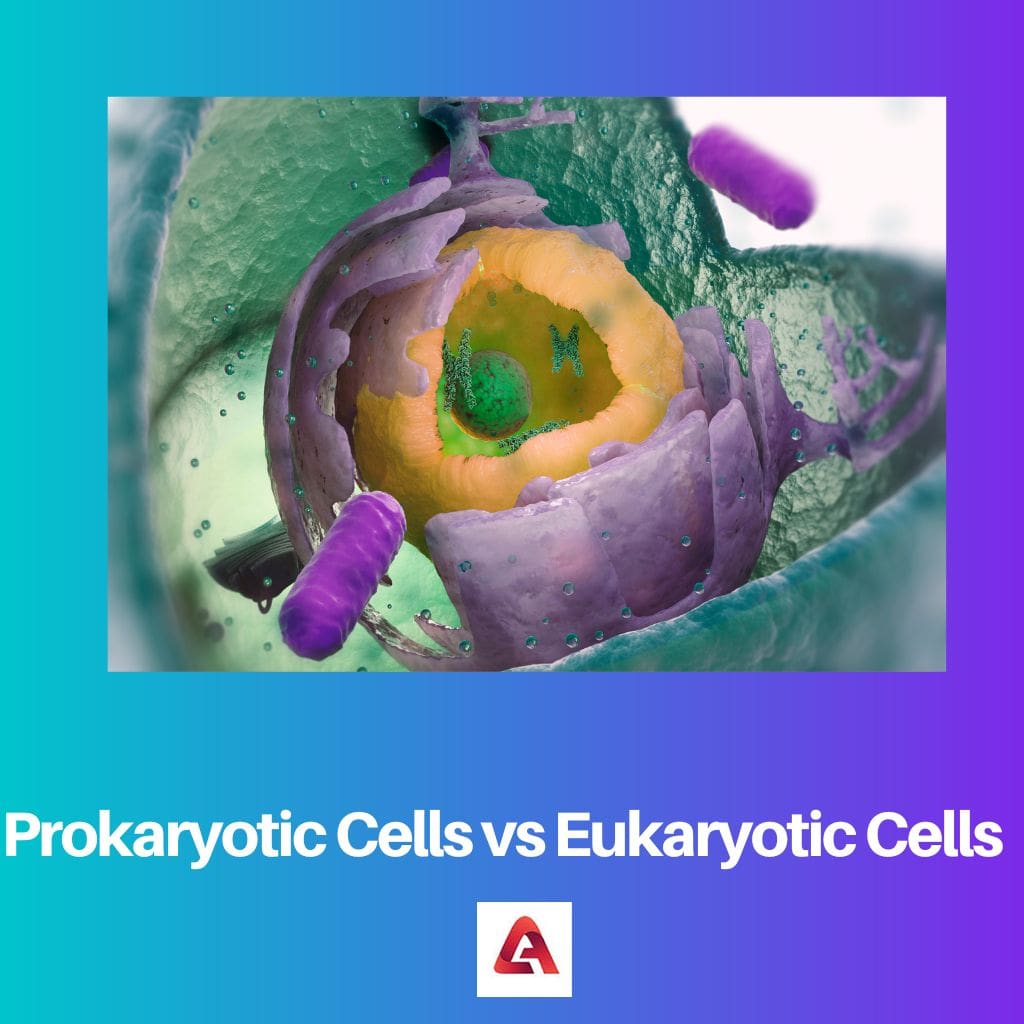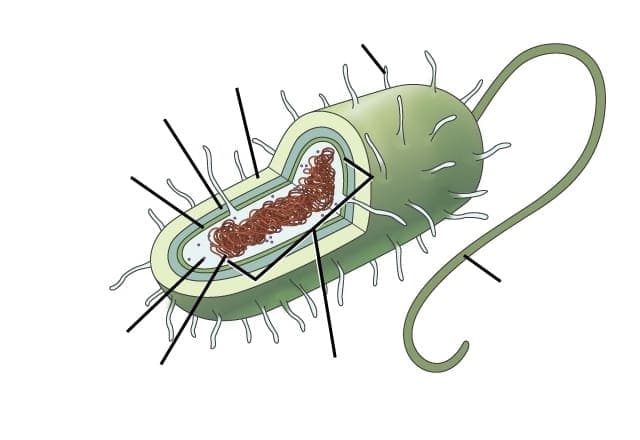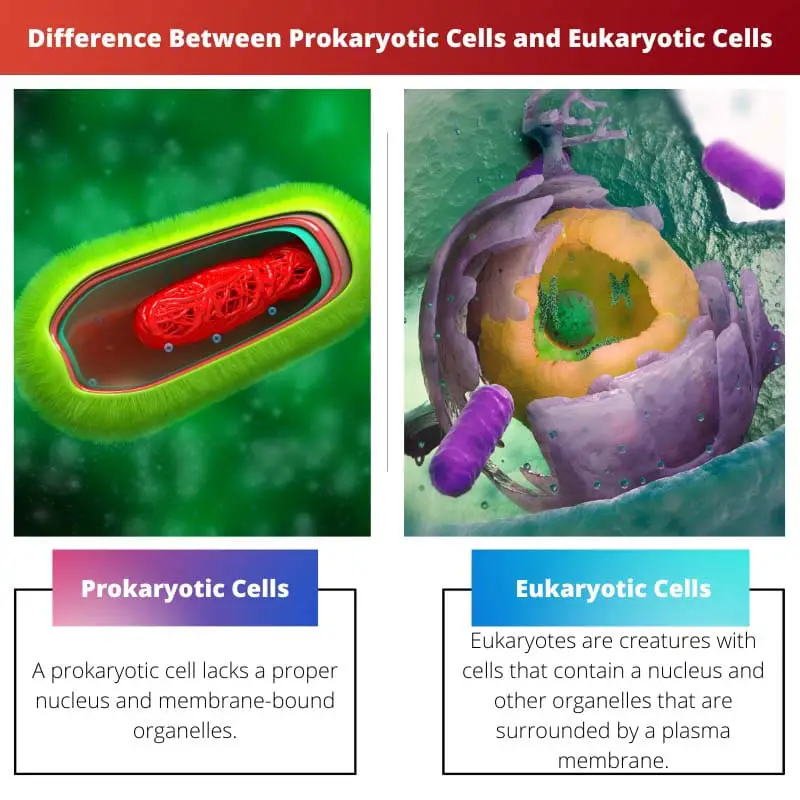All living species refer to the cell as the structural and functional unit. The word cell comes from Latin and means “little apartment” when translated.
It was originally observed in 1665 by Robert Hooke. Two main categories of cells are prokaryotic cells and eukaryotic cells. They differ on multiple parameters.
Key Takeaways
- Prokaryotic cells are simpler and smaller than eukaryotic cells, lacking a nucleus and membrane-bound organelles.
- Eukaryotic cells contain a nucleus and various membrane-bound organelles, allowing for more complex cellular processes.
- Prokaryotic cells are found in bacteria and archaea, while eukaryotic cells comprise plants, animals, fungi, and protists.
Prokaryotic Cells vs Eukaryotic Cells
Prokaryotic cells are smaller, simpler cells that lack a nucleus and other membrane-bound organelles. They are found in bacteria and archaea. Eukaryotic cells are larger, more complex cells with a nucleus and other membrane-bound organelles and are found in all other life forms like plants, etc.

A prokaryotic cell lacks a proper nucleus and membrane-bound organelles. Bacteria and Archaea organisms are founded on the prokaryotic cell, whereas all other forms of life are eukaryotic.
However, species with prokaryotic cells are abundant and account for a large portion of the Earth’s biomass. Bacteria and Archaea are prokaryotes. Cyanobacteria are photosynthetic prokaryotes.
Eukaryotes are creatures with cells that contain a nucleus and other organelles that are surrounded by a plasma membrane.
Organelles are internal structures that perform several activities, including energy generation and protein synthesis.
Eukaryotic cells are huge (about 10-100 m in diameter) and complicated. While the majority of eukaryotes are multicellular creatures, some are single-cell eukaryotes.
Comparison Table
| Parameters of Comparison | Prokaryotic Cells | Eukaryotic Cells |
|---|---|---|
| Type of Cell | Unicellular | Unicellular and multicellular |
| Chemical Nature | Complex | Simple |
| Nucleus | Absent | Present |
| Cell Size | Smaller | Larger |
| Ribosome Size | Smaller | Larger |
| Ribosome Shape | Spherical | Linear |
| DNA Arrangement | Circular | Linear |
| Plasmids | Present | Very rarely found |
| Reproduction | Asexual | Asexual and sexual |
| Endoplasmic Reticulum | Absent | Present |
What are Prokaryotic Cells?
Any creature that lacks a recognizable nucleus and organelles owing to the unavailability of internal membranes is referred to as a prokaryote. Bacteria are one of the most well-known prokaryotic species.
Prokaryotes are distinguished from eukaryotes by the absence of internal membranes. Flagella are seen in some prokaryotes. Prokaryotic flagella differ from eukaryotic flagella in their architecture and movement.
Mesosomes are peculiar structures seen in some bacterial cells that help with cellular respiration. Plasmids, which are tiny, circular fragments of DNA, are found in most prokaryotes.
Flagella are present to aid motility, although pilus can also be used as a locomotion aid. Bacteria and archaea are examples of prokaryotic organisms. In addition, every member of Kingdom Monera is a prokaryote.
Prokaryotic cells are the most primordial cells from a morphological perspective. Bacteria and cyanobacteria are examples of organisms that lack a distinct nucleus (blue-green algae).
The chromatin bodies are dispersed throughout the cytoplasm. Asexual division in prokaryotes is essentially binary fission. Eukaryotes are much larger than prokaryotes.
Furthermore, a prokaryotic cell has only one membrane, which serves as an exterior membrane for the cell. Eukaryotic cells, on the other hand, contain a nuclear membrane that surrounds the nucleus.
Bacteria and archaea are prokaryotic cells. Their DNA is not housed within a nucleus, and they have a diameter of 0.1–5 m. Instead, their DNA is circular.
Prokaryotes are organisms made up of only one prokaryotic cell. Prokaryotic cells are microorganisms that are thought to be the first on the planet.

What are Eukaryotic Cells?
Chloroplasts are the photosynthetic subcellular locations found solely in plant cells. The endoplasmic reticulum aids in material movement.
Other cell organelles that perform different activities include Golgi bodies, vacuoles, ribosomes, chromosomes, lysosomes, cytoplasm, and centrosomes.
The eukaryotes are thought to have developed from prokaryotes. They are distinguished by the presence of a membrane nucleus.
They contain organelles such as mitochondria that are surrounded by membranes and are found in the cytoplasm. They have a well-defined nucleus.
A nuclear membrane surrounds the chromatin bodies. In eukaryotes, both asexual and sexual division occurs. They are bigger than prokaryotes and exhibit superior structural organization and functional efficiency.
Eukaryotic cells have a nucleus and organelles and are surrounded by a plasma membrane. Fungi, mammals, plants, and protozoa are examples of creatures with eukaryotic cells.
Furthermore, these creatures are classified as Eukaryota in the biological realm.
Organelles are structures found in eukaryotic cells. Furthermore, organelles provide many functions throughout the cell. Furthermore, ribosomes, the endoplasmic reticulum, and mitochondria are examples of organelles.
Eukaryotic cells have a genuine nucleus that is surrounded by a nuclear envelope. It also possesses the genetic substance DNA.
Furthermore, the cytoskeleton provides physical support and stabilization to all organelles, facilitating signal transmission from one cell component to another.
The cytoskeleton of eukaryotic cells is made up mostly of three types of filaments: microfilaments, microtubules, and intermediate filaments. In addition, the cytosol is a gel-like substance that surrounds every organelle in the cell.

Main Differences Between Prokaryotic Cells and Eukaryotic Cells
- All prokaryotic cells are unicellular, whereas eukaryotic cells are both unicellular and multicellular.
- The chemical nature of prokaryotic cells is complex and eukaryotic cells are simple.
- Prokaryotic cells don’t have a nucleus which is present in eukaryotic cells.
- Prokaryotic cells are smaller in size than eukaryotic cells.
- The size of the ribosomes in prokaryotic cells is smaller when compared to the ribosomes of eukaryotic cells.
- Prokaryotic cells have spherical-shaped ribosomes, and eukaryotic cells have linear-shaped ribosomes.
- The DNA arrangement is circular in prokaryotic cells and linear in eukaryotic cells.
- Plasmids are abundantly present in prokaryotic cells but are very rarely found in eukaryotic cells.
- Prokaryotic cells only go through asexual reproduction. On the other hand, eukaryotic cells go through asexual and sexual reproduction.
- Prokaryotic cells have no endoplasmic reticulum, but eukaryotic cells do have endoplasmic reticulum.
